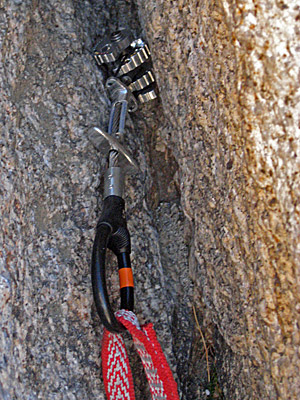Metolius Offset Master Cams Review
 One of the more pleasant surprises at last summer’s Outdoor Retailer trade show was the announcement by Metolius that not only were offset Master Cams on the agenda, but they would be shipping out in the fall. Usually you see a new product at the show and it wont be out for six months, at the minimum. Not so in this case, and we’ve been abusing testing some units at a variety of crags over the last couple of months.
One of the more pleasant surprises at last summer’s Outdoor Retailer trade show was the announcement by Metolius that not only were offset Master Cams on the agenda, but they would be shipping out in the fall. Usually you see a new product at the show and it wont be out for six months, at the minimum. Not so in this case, and we’ve been abusing testing some units at a variety of crags over the last couple of months.
At first glance, these are beautifully made cams. They exhibit the same high quality that seems prevalent in everything Metolius manufactures. Plus they’re made in the USA, which is always a bonus! When the Master Cams first came out, it was obvious the next step would be an offset version, and these have proven to be a very useful extension of that line.
When I show the cams to folks, many wonder how practical an offset cam really is, but I think that’s simply because we’ve all been trained to look for parallel sided cam placements. In most rock, cracks are not perfectly parallel, instead featuring a variety of undulations that are well suited for these cams. Also, there are times when only an offset will work, like flaring pin scars and water grooves that are common at many granite climbing areas.
That being said, we’ve found them to be most useful in granite, as the varied nature of most cracks in this type of rock creates many possibilities for good placements. Old pin scars can now be protected, and the dreaded Lumpy Ridge water grooves also are no longer to be feared (quite as much anyway) with a set of these on your rack. The other place we found them to be indepensible is on the heavily flared pin scars of Zion. On a recent trip, they provided secure protection where nothing else would work. Well, maybe a tricam, but who really climbs with those anyway?
The only negative thing I’ve encountered is it’s next to impossible to place these things blindly. You really need to be able to see the cams to make sure that all of them are in contact with the rock properly, so shoving them in around a corner is best saved for the regular units. That’s about our only concern so far, and since we’ve been using them to supplement our standard rack, it’s not even much of an issue, just something to keep in mind.
Overall, these cams are highly recommended. Now I know there are the die hard Alien supporters out there, and to them these are probably the Anti-Alien, but if you want an offset cam that’s well made and gives you options for pro when nothing else will work, these are worth a look.
5 Responses to Metolius Offset Master Cams Review
Bulldog Creek Dog Walk (IV WI 4+)
Hayden Carpenter and Tom Bohanon recently repeated an obscure ice climb on the south side of Mt Sopris. Given a brief mention in Jack Robert’s ice guide, Bulldog Creek Walk is described as being 100 meters of WI 4. What they found was seven pitches of ice in a remote setting that makes for one […]
Connect with Us















So far, what seem to be the most useful sizes? Don’t be bustin’ on my beloved tri cams, the pink one is the bees knees.
@Yuani – I guess that depends, but the small sizes really seem to come through when you need them most. Seems like with bigger cracks, you can at least get a normal cam in there in a way that will probably work somewaht. With smaller cracks where nothing else fits, these things really shine.
And as for the tricam comment, it was a joke! Most people out west don’t even seem to own them, never mind know how to use them! Having learned to climb in the Gunks, I have many fond memories of fiddling in the red and pink. Keep on keeping on all you tricam lovers out there!
Yeah lay off the tri-cams, they are still lighter and have a better range of sizes than most cams.
Does a pink tricam appreciation society exist?
Not sure, but you could start one by going down to zion and signing up any aid climber fresh off a wall.